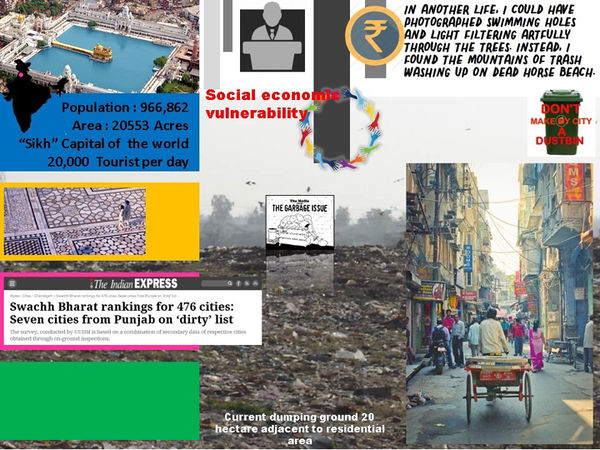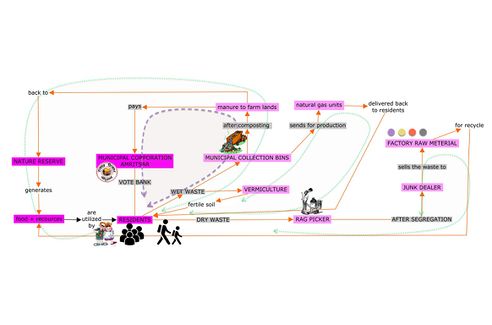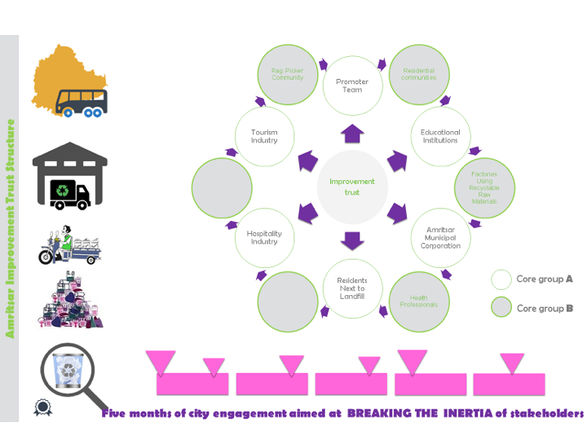Landscape Democracy 2015 Working Group C - Case Study 3
---> back to group page working group C
RETURNING SCAPE TO THE URBAN HERITAGE LAND
| Place name | Amritsar City | |
| Location | North India | |
| Country | India | |
| Author(s) | Stuti Sareen | |

| ||
|
| ||
RATIONALE:
- The case of garbage, especially the domestic garbage has spoiled the rich urban landscape of the heritage city and thus has become one of the major cause of all ecological imbalances that prevail in 'urban' indian society today.
- Garbage process is not elaborate at the moment it starts with majorly informal and some formal collection practices and ends up majorly at horundes landfill sites near the residential areas in the city. Amritsar being the capital for Sikh religion (which counts for nearly 0.4% of the total world population) and having nearly 20,000 visitors everyday and shooting up to 100,000 on special occasions makes it important destination on the world map.
- The city of 1 million people is drowning into its own garbage and has been recorded on last in the intra-country class A cities, cleanliness ranking list. This is hazardously countering the basic human rights of healthy living as a community.
THE CASE OF CITY AMRITSAR GARBAGE PROBLEM
Solid waste management is the prime responsibility of the Municipal Corporation Amritsar involving collection, storage, segregation, transportation and disposal.In Amritsar urban limits, house to house collection of the solid waste is carried out through a number of sanitary workers deployed by the Municipal Corporation, payment of which is made on shared basis by Corporation. The total generation of solid waste in the city of Amritsar is estimated to be 600 tons per day (TPD). This large amount of solid waste generated is disposed off on the landfill site located outside Bhagtanwala.
Seeing the large amount of generation of solid waste in the city, Municipal Corporation of Amritsar has undertaken the project of Integrated Solid Waste Management Project under JNNURM to scientifically dispose off the solid waste. This MSW project is divided into two phases. The first phase of the project includes collection, segregation, storage and transportation of the municipal solid waste, and the second phase of the project includes processing and disposal of solid waste, which has been allotted to different private companies called concessionaires.
Solid waste comprises of waste generated from different sources. Major sources of generation are individuals, households, industries, trade and commerce, hotels and restaurants, healthcare institutions including dispensaries and hospitals, animals and floating populations in terms of tourists, hawkers, etc. TYPES OF WASTE Solid waste generated can be broadly classified into 4 categories i.e
- Organic Waste, which includes kitchen waste (food items), leaves, remains of
animals slaughtered, etc.,
- Recyclable Waste, which includes paper, plastic, glass, metal, rags, packing materials, twigs, bark, etc.,
- Inert Waste including bricks, cement, building debris, furniture waste, etc.
- Industrial Waste, which includes the byproducts.
In addition, large amount of waste is also generated by number of hospitals, dispensaries and other health care institutions, which are operational in the city. The current addition is E Waste generated from electronic products whose quantity is alarmingly increasing in the city.
In terms of waste generated, organic waste comprises of more than half of the total waste whereas inert waste is more than 1/4 of the total waste generated. Industrial waste as well as recyclable waste comprises of approx 1/10th each of waste generated. There is no segregation of waste at the point of generation.
COLLECTION The present system of waste collection, storage and transportation in the Amritsar Municipal Corporation (MCA) is of primitive age old type. They are not in compliance with MSW Rules 2000. The daily collection of solid waste in the city is reported to be 100 percent, which is not the case. Different methods of collection of solid waste are practiced in the city. At the household level, Door to Door collection of waste is practiced. Since household waste has high contents of organic waste, no system of segregation is used at the generation level. In the process, the quality of recyclable material gets distorted due to mixing of the dry and wet waste.
For the house to house collection of waste - waste collection trolleys, rickshaw rehris and tricycles having back space as storage bins are operational in Amritsar. The areas where house to house collection system is not provided, community bins are strategically provided by the corporation for their direct use by the surrounding inhabitants. However, numbers of bins provided by the Corporation are inadequate to take care of the waste generated and accordingly, at many places open spaces and roadsides have emerged as the preferred dumping sites.
In all the other four urban settlements, each ward has been considered as a zone for collection of solid waste. The house to house or door to door collection of waste is done by the safai sewaks (sanitary workers) in all the wards using hand carts or push carts or tricycles. The collected waste is taken in a wheelbarrow or in polythene bag and dumped on the designated points, called as waste collection points or bins, which act as waste storage points from where they are transported for final disposal to the landfill site.
SEGREGATION Most of the city inhabitants carry out segregation at the household level by salvaging resaleable material from waste such as newspaper, glass bottles, empty tins, plastic bags, old cloths, etc. and sell it directly to Kabaris(junk dealer). In addition, rag pickers also take rounds of the street and visit the collection centers for salvaging the recyclable waste for selling and income generation. As such, segregation of organic and inorganic waste at the source or generation point is not practiced.
TRANSPORTATION For the transportation of the solid waste from the collection centre to the disposal site, Amritsar M.C. has deployed number of vehicles including tractor trolleys and 3 large size trucks having a capacity of 10 tons. These vehicles are used for primary collection of waste from the community bins and its transportation to designated landfill site. 7 front end loaders are also operational in the city for loading waste into trailers by lifting storage bins and emptying them into the tractor trailers before transportation.
VIDEO REFRENCE FOR THE OBSERVATIONS IN DIFFERENT PARTS OF THE COUNTRY
KEY ISSUES
Despite the fact that Municipal Corporation deploys the largest manpower and resources for the solid waste management, heaps of stinking waste can be seen all over the city. Not only households and individuals contribute to the present scenario, but manpower deployed has also been a major contributor in making the city unhygienic. The removal of garbage is carried out in arbitrary manner and cleaning of roads is done in most unprofessional manner. Solid waste management has emerged as the most challenging task for all local bodies. Keys issues involved in solid waste management in Amritsar Corporation area are:
- Absence of public participation and lack of public awareness.
- Absence of scientific collection and disposal.
- Absence of solid waste treatment plant in the city.
- Untrained and unqualified man power deployed in the process of solid waste management.
- Absence of segregation of waste at the generation level. This is preventing the use of degradable waste as manure.
- Inadequate and out dated collection and storage infrastructure in use by MCA.
- Unhygienic condition of dumping sites and absence of scientific system of landfill management.
- Open dumping along roadsides, railway lines, vacant plots, drains/nallahs, mandis, etc. The dumping of agricultural waste outside Bhagtanwala Gate is creating a lot of menace.
- Absence of involvement of rag pickers in recovery of valuable recyclable waste.
- Absence of involvement of institutions involved in generation of large quantity of waste.
- Mixing of industrial and toxic waste with the domestic waste.
- No proper system to collect and treat medical waste of the hospitals and nursing homes.
- Lower level of collection of solid waste generated on daily basis.
- Absence of mechanisms for converting waste into wealth.
The below Graphic explains the present situation of garbage disposal in the city of amritsar. In the present scenario of economic greed the domestic and and the waste from hospitality industries has a blocked end in the land fill sites whereas the situation can be turned to a win win scenario for all. the economic loop for fulfilment of financial resources of government can also be achieved by completing the cycle of organic and inorganic waste judiciously. This needs dedicated performance and participation from all the stakeholders.
- PRESENT AND VISIONED SCENARIO
What could be a starting point for democratically-based change?
It can be observed so far that the problem in the system of collection, segregation, transportation and disposal of urban waste lies in the lack of information and interest of not only the government bodies but also the general public of the city. The tool that can be adopted for improving the situation is public participation and realizing the values of democracy for eradicating the social cum physical problem of the place. Since the cycle of waste is observed to be incomplete that is the waste that originates from households and other industries should be processed and reused or recycled back to the nature or as the raw material of various industries. The situation calls for public participation for which MASS MEDIA, LOCAL REFORM GROUPS and INSTITUTIONS can be used as the physical tools for promotion of the public participatory project.
- OBSERVATIONS
Stakeholder Mapping
The stakeholder engagement mapping for the concerned problem in the city of amritsar is proved to be one of the starting tool in drawing the initial lines of the project. the various stakeholders could now be identified and categorised on the basis of the benefit, need(social and health based), and also the power handling parties.
On the basis of the stakeholder mapping a body of various stakeholders can be formed to be known as "Amritsar Improvement trust" with participating Core Group A with high need and Core Group B with relatively low need but the ones who can act as promoters.
- Stakeholder Map
Change Scenario
A Five months engagement program is designed using various methods and tools of public participation aimed at breaking the inertia of the stakeholders.
The Key principles for the aimed PPP (public participatory project) are;
- Accepting the agendas of stakeholders and addressing them judiciously,
- Training and building local capacity,
- Communication enhancement for inculcation sense of community and citizenship,
- Addressing at human scale and breaking down into smaller parts
- Using Visual and electronic media to enhance participation and involvement at all levels
- Change Scenario
Cross cutting theme
The study cases come from different location and a different social process, they have in certain things in common that they aim at improving the quality of life through the creation of a better environment with visionary public participatory project. The projects are aimed at motivation and education of the people or say various stakeholder groups to get involved in for a initially maybe a specific agenda and for achieving the goal of the better environment in and maintaining it in a democratic way. though the case studies reflect different area zones of the urban landscape like the inner city or the outskirts it is deemed to imrove the connections with the land and benefit as a whole.
Concluding reflections
Landscape and and democracy as term and meanings can play an important influential role in sustaining and maintaining each other. Since the landscape provides the background the democracy in its real terms can be used as a tool to not only reflect the aspirations of the present generations but also is important to cultivate the futures. thus if this democracy based model is applied for the improvement of physical and social structure of the society it can prove to be an important start point to ignite the feeling of belonging and citizenship. though with the factor involving various stakeholders rooted into one big problem it is a challenge to bring about a change overnight but nevertheless a good start can prove to be an example for the process to continue till the desired results are achieved.
References
https://www.youtube.com/watch?v=lS0_FCBzI_w
http://www.swachcoop.com/swach-presentevents.html










